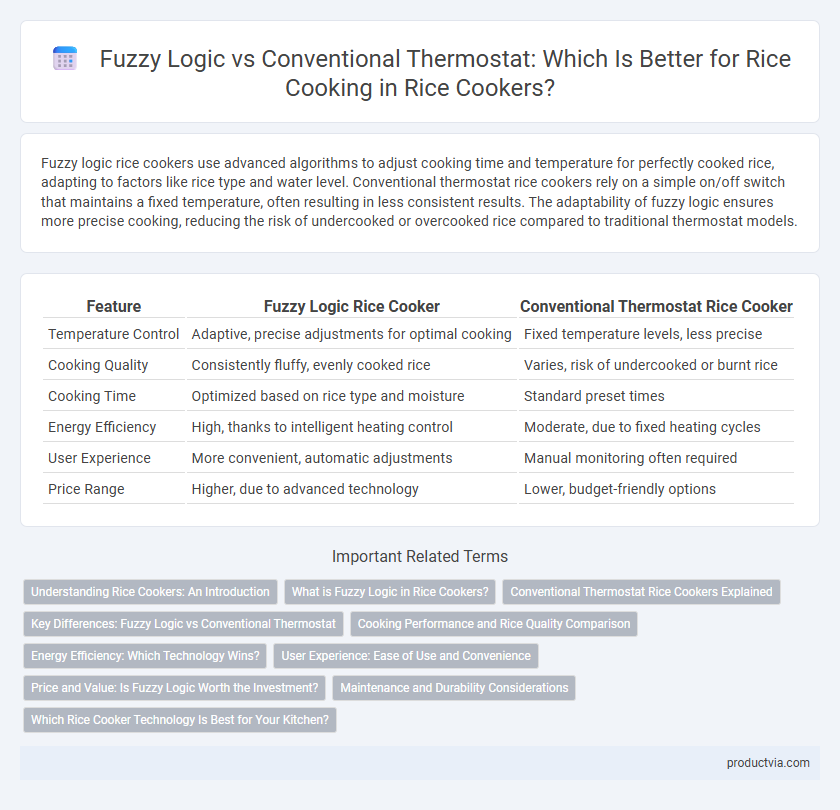Fuzzy logic rice cookers use advanced algorithms to adjust cooking time and temperature for perfectly cooked rice, adapting to factors like rice type and water level. Conventional thermostat rice cookers rely on a simple on/off switch that maintains a fixed temperature, often resulting in less consistent results. The adaptability of fuzzy logic ensures more precise cooking, reducing the risk of undercooked or overcooked rice compared to traditional thermostat models.
Table of Comparison
| Feature | Fuzzy Logic Rice Cooker | Conventional Thermostat Rice Cooker |
|---|---|---|
| Temperature Control | Adaptive, precise adjustments for optimal cooking | Fixed temperature levels, less precise |
| Cooking Quality | Consistently fluffy, evenly cooked rice | Varies, risk of undercooked or burnt rice |
| Cooking Time | Optimized based on rice type and moisture | Standard preset times |
| Energy Efficiency | High, thanks to intelligent heating control | Moderate, due to fixed heating cycles |
| User Experience | More convenient, automatic adjustments | Manual monitoring often required |
| Price Range | Higher, due to advanced technology | Lower, budget-friendly options |
Understanding Rice Cookers: An Introduction
Fuzzy logic rice cookers use advanced algorithms to precisely control temperature and cooking time, adapting to different rice types and ensuring optimal texture. Conventional thermostat models rely on fixed temperature settings, which can result in less consistent cooking outcomes. The intelligent adjustments of fuzzy logic technology enhance energy efficiency and improve the overall cooking experience compared to traditional thermostats.
What is Fuzzy Logic in Rice Cookers?
Fuzzy logic in rice cookers refers to an advanced microcomputer technology that continuously monitors and adjusts cooking parameters such as temperature and cooking time for optimal results. Unlike conventional thermostats that operate on fixed settings, fuzzy logic mimics human decision-making by making precise adjustments based on real-time feedback during the cooking process. This technology ensures more consistent, evenly cooked rice by adapting to variations in rice type, moisture content, and ambient conditions.
Conventional Thermostat Rice Cookers Explained
Conventional thermostat rice cookers regulate temperature using a simple on-off mechanism to maintain heat within a set range, often resulting in less precise cooking control compared to advanced models. These cookers switch the heating element off when the internal temperature reaches a preset level, typically around 212degF (100degC), and switch back on when the temperature drops, which may cause inconsistent texture and overcooking. While they are reliable and affordable, conventional thermostat rice cookers lack the adaptive heating adjustments provided by fuzzy logic technology, leading to a more basic cooking performance.
Key Differences: Fuzzy Logic vs Conventional Thermostat
Fuzzy logic rice cookers adjust temperature and cooking time dynamically based on continuous feedback, ensuring precise cooking results and improved texture. Conventional thermostat rice cookers operate using fixed temperature settings that cycle on and off, which may result in uneven heating and less consistent rice quality. The key difference lies in fuzzy logic's ability to mimic human decision-making for optimal cooking versus the more rigid, binary control of conventional thermostats.
Cooking Performance and Rice Quality Comparison
Fuzzy logic rice cookers use micro-computer technology to adjust temperature and cooking time precisely, resulting in evenly cooked rice with optimal texture and moisture. Conventional thermostat rice cookers operate on fixed temperature settings, often causing inconsistent cooking performance and unevenly cooked rice. The adaptive control of fuzzy logic enhances rice quality by preventing overcooking or undercooking, delivering consistently fluffy and well-textured results.
Energy Efficiency: Which Technology Wins?
Fuzzy logic rice cookers optimize cooking by continuously adjusting temperature and cooking time based on moisture and temperature feedback, resulting in significant energy savings compared to conventional thermostat models. Conventional thermostats operate with fixed temperature settings, leading to frequent cycling and energy wastage due to less precise control. Studies indicate fuzzy logic rice cookers can reduce energy consumption by up to 20%, enhancing overall energy efficiency in rice cooking.
User Experience: Ease of Use and Convenience
Fuzzy logic rice cookers automatically adjust cooking time and temperature based on real-time feedback, offering a more precise and hassle-free cooking process compared to conventional thermostat models. Users experience greater convenience as fuzzy logic technology reduces the need for manual monitoring and prevents overcooking or undercooking. This advanced feature enhances ease of use, making it ideal for busy individuals seeking consistently perfect rice with minimal effort.
Price and Value: Is Fuzzy Logic Worth the Investment?
Fuzzy logic rice cookers typically cost 20-40% more than conventional thermostat models but offer precise temperature control and adaptive cooking cycles that enhance rice texture and consistency. The increased value is evident in their ability to accommodate different types of rice and cooking conditions, reducing the risk of undercooked or overcooked grains. For frequent rice consumers or those seeking optimal cooking results, the investment in fuzzy logic technology often justifies the higher price through improved meal quality and versatility.
Maintenance and Durability Considerations
Fuzzy logic rice cookers offer advanced temperature control through microprocessor adjustments, resulting in less wear on heating elements and longer lifespan compared to conventional thermostat models that suffer from frequent cycling and temperature fluctuations. Maintenance for fuzzy logic cookers is typically lower due to fewer mechanical parts and consistent cooking performance, reducing the risk of component failure. Conventional thermostats require more frequent calibration and servicing to maintain accuracy, which can compromise durability over time.
Which Rice Cooker Technology Is Best for Your Kitchen?
Fuzzy logic rice cookers use microcomputer technology to adjust temperature and cooking time precisely, resulting in perfectly cooked rice with optimal texture and flavor. Conventional thermostat rice cookers rely on fixed temperature settings, which may lead to uneven cooking or overcooking, especially with different rice varieties. Choosing a fuzzy logic rice cooker ensures more consistent results and better adaptability for diverse kitchen needs.
Fuzzy logic vs conventional thermostat for rice cooking Infographic

 productvia.com
productvia.com